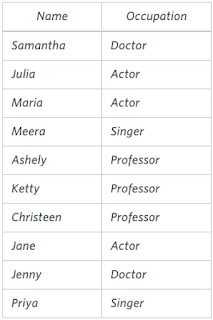I started studying SQL from a very famous site - HackerRank. Here I will try to provide multiple approaches & solutions to the same problem. It will help you learn and understand SQL in a better way.
Please make use of my blog posts for learning purpose only and feel free to ask your questions in the comment box below in case of any doubt.
Click Here for the previous blog-post in the series.
Recommended SQL Courses:
SQL Problem Statement:
Generate the following two result sets:
- Query an alphabetically ordered list of all names in OCCUPATIONS, immediately followed by the first letter of each profession as a parenthetical (i.e.:enclosed in parentheses). For example: AnActorName(A), ADoctorName(D), AProfessorName(P), and ASingerName(S).
- Query the number of ocurrences of each occupation in OCCUPATIONS. Sort the occurrences in ascending order, and output them in the following format:
where [occupation_count] is the number of occurrences of an occupation in OCCUPATIONS and [occupation] is the lowercase occupation name. If more than one Occupation has the same [occupation_count], they should be ordered alphabetically.
Note: There will be at least two entries in the table for each type of occupation.
Input Format:
The OCCUPATIONS table is described as follows:
 |
| OCCUPATIONS Columns |
Sample Input:
An OCCUPATIONS table that contains the following records:
Sample Output:
The results of the first query are formatted to the problem description's specifications.
The results of the second query are ascendingly ordered first by number of names corresponding to each profession (2<=2<=3<=3), and then alphabetically by profession (doctor <= singer, and actor <= professor).
Solution: Using CONCAT & LEFT function (MySQL Query):
NOTE:
- CONCAT function is used to concatenate multiple strings.
- LEFT function is used to take the substring from left, '1' is passed parameter to select only 1 character from the left.
Sample Output:
--------------------------------------------------------------------------------
Click here to see solutions for all Machine Learning Coursera Assignments.
&
Click here to see more codes for Raspberry Pi 3 and similar Family.
&
Click here to see more codes for NodeMCU ESP8266 and similar Family.
&
Click here to see more codes for Arduino Mega (ATMega 2560) and similar Family.
Feel free to ask doubts in the comment section. I will try my best to answer it.
If you find this helpful by any mean like, comment and share the post.
This is the simplest way to encourage me to keep doing such work.
Thanks & Regards,
-Akshay P Daga

![HackerRank: [Advanced Select - 2/5] The PADS | CONCAT, LEFT, GROUP BY in SQL HackerRank: [Advanced Select - 2/5] The PADS | CONCAT, LEFT, GROUP BY in SQL](https://blogger.googleusercontent.com/img/b/R29vZ2xl/AVvXsEgdck_H6FLADoveRlxe75_7AFTX4ZERFdu0BVR1ciPT3MqFI0Rd3vP20agp-_73PBhyphenhyphenb1WzpTpqp683ZUncSSpAzP-wO90hOkknsduVDWmuaC4kRb_RB7XbE_lt_DJS2M14kSd8ZiPElOM/s600/HackerRank+Advanced+Select+2_5-min.png)
